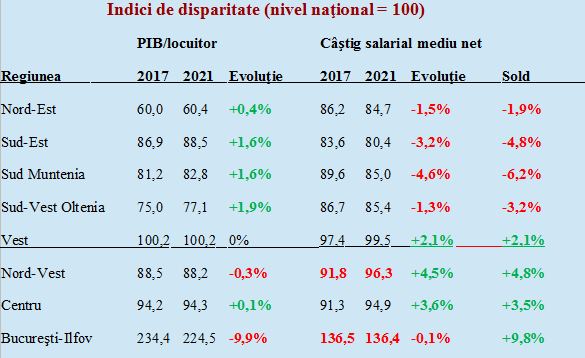 Development disparities between Romania’s regions have diminished since the European integration, but the gaps between the relative incomes of people living in these regions have increased, according to data released by the National Prognosis Commission (CNP).
Development disparities between Romania’s regions have diminished since the European integration, but the gaps between the relative incomes of people living in these regions have increased, according to data released by the National Prognosis Commission (CNP).
Moreover, the trend will continue in the next four years in Moldova, Muntenia, Dobrogea and Oltenia.
The future looks bad:
Polarization of the benefits at the individual level related to the economic results embodied in GDP per capita will have a significant increase exactly in the capital city region, where the living standard deviations in relation to the surrounding area will deepen at the highest rates (-6.2% in the South Muntenia region and -4.8% in the South-East region, see the table).
*
- Disparity indices (national level = 100)
- GDP/capita Average net salary
- Region 2017 2021 Evolution 2017 2021 Evolution Balance
*
Gaps will increase:
According to CNP’s projections, net beneficiaries related to the increase in the economic performance will be exactly the most developed regions of Romania, namely West (+ 2.1% in salary income, without an increase compared to the national average), Centre (net advantage of + 3.5%) and North-West (+ 4.8%).
Although we shall witness a relative decrease in GDP per capita in the Bucharest-Ilfov region compared to the national average, the decrease in the incomes will be insignificant (-0.1%), which leads to the biggest advantage for the next four years in terms of GDP/capita and salaries (+ 9.8%).
Of course, it can be argued that salaries were anyway far too low in relation to GDP per capita in the regions that are more developed and too high in the regions lagging behind but what will count in the public perception and individual decision will be the opportunity to gain as much as possible from the current situation.
From this point of view, beyond the strong investment deficit in the East and the South of Carpathians (except for Bucharest but think about what would have happened if we had the capital city somewhere in the central region of the country) aggravated by the lack of modern transportation routes, a problem arises at the human level in terms of remuneration for possible efforts to bring the disadvantaged regions closer to the national average.
*
- Regional gaps (West region =100)
- GDP/capita Net average salary
- Region Change
*
The data already consolidated as a trend over several years following the European integration (which, in theory, should have brought substantial funds for regional development) show that it is not worth the effort.
Social disintegration phenomenon and lack of targeted public investment
Discrepancies between the GDP per capita growth and the relative decrease in the salary incomes in the same four less developed regions of Romania compared to the national average appear to be outrageous.
So outrageous that the reaction of those involved has already been unleashed, with the decrease in the relative GDP in 2021 compared to 2014 in three of the four regions. Followed by the drastic punishment by an even greater decrease in the net average salary.
For reasons of profitability poorly channelled by the state, the cohesion between historical provinces suffers and the exodus of the most capable people to the single European labour market will amplify the discrepancies.
All in all, there are incontestable statistical signs that Romania is socially disintegrating, and the allocation of resources based on the principle of maximizing the earnings by ignoring the – economic or social – polarization creates monsters in the absence of targeted and coherent government policies. A state forced „de facto” to rapidly and massively make public investment in communication channels that would create business opportunities, to reverse this extremely dangerous trend.











